
Don’t get the reference? It’s about a quote popularly attributed to Bill Gates.

Don’t get the reference? It’s about a quote popularly attributed to Bill Gates.

“I have the second toughest mobile evangelist job,” I used to say when I was a Windows Phone champ. “The toughest job…that’s Alec’s.”
Anybody can promote the Android and iOS platforms to developers. Taking on the job of being the head of BlackBerry’s developer relations team in late 2011, in the era of iOS 5 and the beginnings of Android 4 called for a rock star, ninja, and Jedi master all rolled up into one person. Luckily, Alec Saunders fits that description, and for three years he worked tirelessly to bring developers to the BlackBerry platform.
Yesterday, he announced that his last day at BlackBerry/QNX would be “sometime between now and November 3”. I don’t know what his plans are, but from one tech evangelist to another, I wish him the best in whatever challenge he takes on next, and thank him for honoring the profession through his hard work, and his fearlessness in taking on a cheesy ’80s hit in a “rally the BlackBerry troops” music video. You know the one I’m talking about…
I can’t think of a more fitting way to send him a tribute than with the same song:
I’m wishing you the best of luck, Alec, but I know you’ll kick ass wherever you go.
I was taking a trip down memory lane, flipping through an old Bloom County collection when I saw this classic strip…
Click on the comic strip to see the source.
…and it occurred to me: this is how a lot of so-called “agile” software projects are run.
On second thought, make that software projects, period.
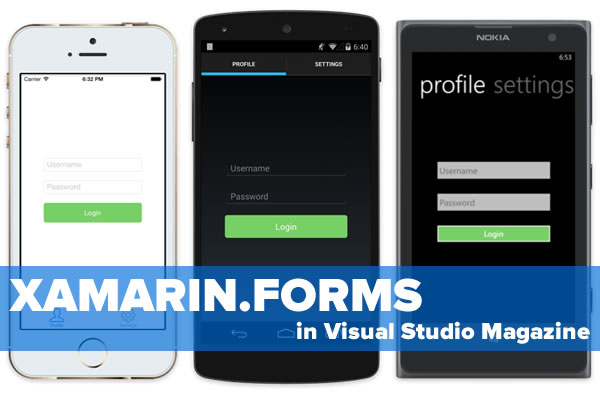
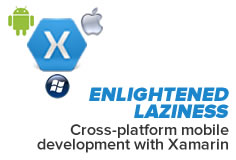 It’s a sign of the times when Visual Studio Magazine covers a development tool that’s neither Visual Studio nor even made by Microsoft. Lately, they’ve been giving a lot of love to Xamarin, which lets you code with C# and the .NET Framework to create native Android, iOS, MacOS, and Windows apps, with particular attention paid to Xamarin.Forms, their new cross-platform UI API that lets you target Android, iOS, and Windows Phone with a single code base.
It’s a sign of the times when Visual Studio Magazine covers a development tool that’s neither Visual Studio nor even made by Microsoft. Lately, they’ve been giving a lot of love to Xamarin, which lets you code with C# and the .NET Framework to create native Android, iOS, MacOS, and Windows apps, with particular attention paid to Xamarin.Forms, their new cross-platform UI API that lets you target Android, iOS, and Windows Phone with a single code base.
With Xamarin.Forms, you build mobile UIs using an API that abstracts away each mobile OS’s particular features as far as the developer is concerned. When you create a Button in Xamarin forms, it becomes an Android Button instance on Android devices and a UIButton view on iOS devices. I’ve been noodling with Xamarin.Forms for the past few weeks and it looks like it’s the tool I’ll use to build sales, marketing, and training apps for partner organizations of GSG, the company I work for.
In their article, Simplifying Cross-Platform Mobile App Development with Xamarin.Forms, Visual Studio Magazine’s Wallace McClure suggests that you ask these questions when considering adopting Xamarin.Forms as your development platform:
The article also features a sample app, which takes JSON data from a remote source via .NET’s HttpClient and displays it in list form as shown below:
It’s worth noting that they don’t show a Windows Phone screenshot — just Android and iOS. You can download the code here.
Another Visual Studio Magazine article, Xamarin.Forms: What Developers Make of It, has McClure talking to developers who participated in the Xamarin.Forms beta program as well as Xamarin evangelist Craig Dunn. Some quotes:
Xamarin isn’t just doing their part for cross-platform coding, but cross-platform testing as well, with Xamarin Test Cloud. Xamarin Test Cloud lets you test your apps on thousands on devices with your having to acquire them all. According to the Visual Studio Magazine article Xamarin Test Cloud Now Available:
Xamarin Test Cloud can provide simulated testing environments for more than 1,000 devices, from desktops to mobile devices and includes the various OS versions on a number of platforms.
Xamarin Test Cloud can be used to automate testing of apps through its Calabash cross-platform test automation framework whether developers are working in any C# or Ruby supported tool suite, and can report back on memory and CPU usage performance and test durations. Automated testing can be integrated into Team Foundation Server and other continuous integrations systems like Jenkins and TeamCity.
Xamarin Test Cloud is able to gain access and collect diagnostics information from device logs, stack traces and through hardware data to generate performance reports for more accuracy.
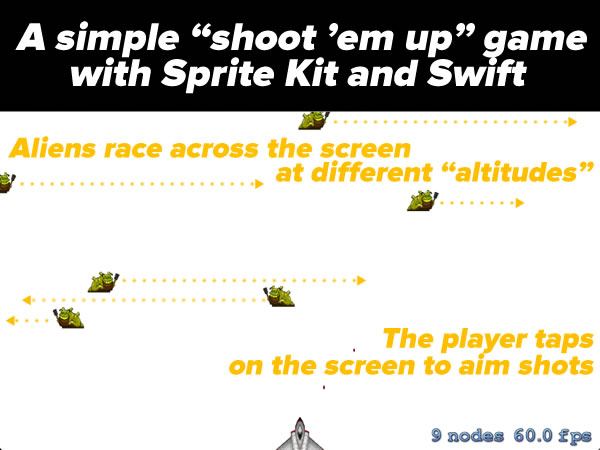
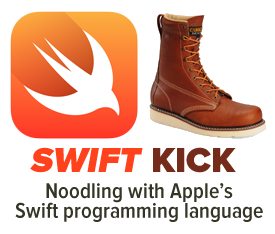 A couple of quick updates about the simple “shoot ’em up” game tutorial app written in Swift with Sprite Kit that I posted a little while back:
A couple of quick updates about the simple “shoot ’em up” game tutorial app written in Swift with Sprite Kit that I posted a little while back:

For those of you who like living on the edge, beta 3 of Xcode 6.1 (the current stable version is 6.0) is now available to registered iOS developers. Of note in this release:
Any can now contain function-type values, as you might come to expect from a value named Any.*LiteralConvertible protocols now use initializers for their requirements rather than static methods starting with convertFrom. Any type that previously conformed to one of these protocols will need to replace its convertFromXXX static methods with the corresponding initializer.fromRaw()/toRaw() enum APIs to the new style-initializer and rawValue property.final to avoid O(n) mutations on value semantic types.XCPShowView() XCPlayground API. This is disabled by default, but can be enabled by checking the Run in Full Simulator checkbox in the Playground Settings inspector. When this checkbox is checked, running the playground will cause the iOS Simulator application to launch and run the playground in the full simulator. This is also required for some other functionality that fails without the full iOS Simulator, such as NSURLConnection http requests. Running in the full iOS Simulator is slower than running in the default mode.expr, p, and print that are evaluated from the LLDB prompt in the Debugger console will now work on 32-bit iOS devices.Also available for download is iOS 8.1 beta. As with Xcode 6.1 beta, you have to be a registered Apple developer to get it now.
Remember, these are betas, and the standard caveats apply.
I’ll close with the Dirty Harry clip referenced in the photo at the top of this article, for the benefit of younger readers who may not be familiar with Mr. Clint Eastwood’s iconic character:
Investment site The Motley Fool points to RootMetrics’ report for mobile carrier performance for the first half of 2014, which shows Verizon as the best overall performer of the “Big Four”. RootMetrics’ methodology incorporates thousands of mobile network performance tests performed on voice, text, and data from the consumer’s point of view. In the most recent round of these tests, Verizon performed best in reliability, speed, voice call performance, and data performance. AT&T beat them out in text message performance.
Click on any of these test graphs to see the RootMetrics report.
The Motley Fool credits Verizon’s XLTE — their branding for their Advanced Wireless Service (AWS) spectrum — which allows them to offer more than double the bandwidth provided by 4G LTE to customers, and this often yields faster connection speeds. Verizon has made XLTE available to 80% of its wireless market and 35% of devices currently on their network, and nearly all the devices it sells are XLTE-compatible.
Graph from Jan Dawson’s US wireless market trends for 2014 slide deck.
Click to see the source.
Verizon added 1.4 million net new wireless subscriptions in Q2 2014, and most of them — nearly 1.2 million — were tablet subscribers, not phone subscribers. Tablet mobile plan subscriptions are typically secondary subscriptions (with the primary one being for a mobile phone), and this, coupled with the fact that they’re one of the top 2 carriers in the US, suggests that their focus is on retaining customers and keeping their churn rate down. They seem to be succeeding in this goal, considering that they’ve kept their churn to under 1% for postpaid subscribers in Q2 2014.
The last graph in the segment above comes from US wireless market trends for 2014, a slide deck created by Jackdaw Research’s chief analyst, Jan Dawson. The deck looks at the wireless market’s financials (revenues, profitability, capital intensity), subscribers (total subscriptions, net adds, churn), and device trends (subsidies and penetration). If you want a good overview of the market, this is a good place to start.
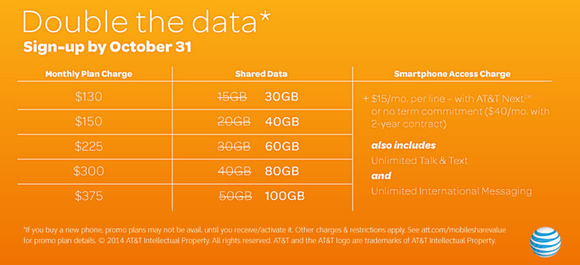
 From now until October 31, a family currently on AT&T’s Mobile Share Value plan can apply to get double the data on their plan for the same price. The deal doesn’t expire once you’ve signed up for it, but you do have to sign up for it, as it’s not automatically offered, and you have to do so before Hallowe’en.
From now until October 31, a family currently on AT&T’s Mobile Share Value plan can apply to get double the data on their plan for the same price. The deal doesn’t expire once you’ve signed up for it, but you do have to sign up for it, as it’s not automatically offered, and you have to do so before Hallowe’en.
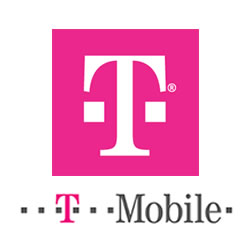 If you’ve got the money to buy it outright from the get-go, T-Mobile can help you; they’re the only US carrier who sells unlocked, contract-free iPhone 6. If you take this route, you’ll have to pay off any installment balance remaining on it and use the T-Mobile network for 40 days, which is the usual policy for T-Mobile. Once those 40 days have passed, you can switch to the network of your choice.
If you’ve got the money to buy it outright from the get-go, T-Mobile can help you; they’re the only US carrier who sells unlocked, contract-free iPhone 6. If you take this route, you’ll have to pay off any installment balance remaining on it and use the T-Mobile network for 40 days, which is the usual policy for T-Mobile. Once those 40 days have passed, you can switch to the network of your choice.